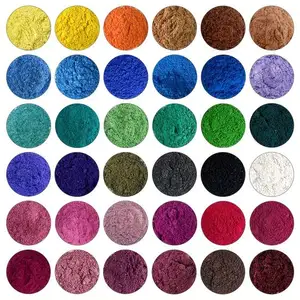Популярное в вашей отрасли






Новый стиль на водной основе цветной пигментный 15 видов цветов для окраски цемента и штукатурки
418,61 ₽ - 592,18 ₽
Минимальный заказ: 1 компл.






Двусторонний высокотемпературный цвет пигмента на бесцветный термохромный пигментный порошок термочувствительный краситель
51,05 ₽ - 102,10 ₽
Минимальный заказ: 20 г







Оксид железа красный/желтый/черный/зеленый/синий оксид железа пигмент для кирпичного бетона
61 259,76 ₽ - 71 469,72 ₽
Минимальный заказ: 2 т







Безопасная для кожи косметическая слюдяная пудра, блестящий жемчужный пигмент для лица, глаз, косметика для губ
61,26 ₽ - 76,58 ₽
Минимальный заказ: 100 шт.







Пигментный Порошок из смолы, 25 цветов, OEM Натуральный слюдяной порошок, окрашивающий краситель для смолы, мыло, свечи, Бомбочки для ванной, слайм, сделай сам
704,49 ₽ - 1 010,79 ₽
Минимальный заказ: 500 компл.






Высокотемпературный порошковый пигмент с эмалью для фарфора
980,16 ₽ - 1 817,38 ₽
Минимальный заказ: 25 кг






Хроматический неорганический керамический пигмент, зеленый для мозаики и керамической плитки
510,50 ₽ - 2 042,00 ₽
Минимальный заказ: 25 кг






Неорганический пигмент 25 кг/мешок оксид железа красный/черный/желтый/синий пигменты для строительства
79,64 ₽ - 86,79 ₽
Минимальный заказ: 1 т





Цветной керамический порошковый пигмент, устойчивый к высоким температурам
510,50 ₽ - 3 267,19 ₽
Минимальный заказ: 25 кг
Связанные запросы:
керамический пятнистый пигментфарфоровый пигмент для керамикикерамические пигменты и пятнакрасный пигмент для керамикилюминесцентные пигменты для керамикипигмент для керамической промышленностикерамический пигмент коричневого цветакитайские пигменты для керамикикерамические пигменты биотиткерамический пигмент с включением оранжевого цветафлуоресцентный пигмент для керамикикобальт синий керамический пигмент для глазурикерамический пигмент тела черный пигменткерамические пигментные глазурикерамический пигмент из оксида меди






Оптовая продажа, 58 цветов, слюдяной порошок, жемчужный пигмент для слизи, эпоксидная смола, литье под давлением
816,80 ₽ - 1 531,50 ₽
Минимальный заказ: 2 кг






Красный пигмент 48:2 Постоянный красный 2BL Быстрый Красный 2BP для ПВХ волокна EVA PE порошковое покрытие
937,28 ₽ - 1 045,50 ₽
Минимальный заказ: 25 кг












Wpc краситель красный оксид железа S110 S 120 S130 S190 пигмент для wpc щепы Мульч краситель
60,24 ₽ - 100,06 ₽
Минимальный заказ: 1000 кг






CLF термохромный пигмент/изменение температуры порошка
19 773,63 ₽ - 25 697,45 ₽
Минимальный заказ: 1 кг






Хамелеоновый пигмент, перекрестная поляризационная Модифицированная форма для ступицы колеса автомобиля, оптическая распылительная краска, меняющая цвет удочка
20 419,92 ₽ - 25 524,90 ₽
Минимальный заказ: 1 кг






Латексная краска текстильная слюдяная Смола органический порошок красный N S 22 пигмент
510,50 ₽ - 714,70 ₽
Минимальный заказ: 200 кг



Лидер продаж Satgurucolourchem, керамическая глазурь, неорганический кристаллический стеклянный мозаичный пигмент
148,05 ₽ - 592,18 ₽
Минимальный заказ: 25 кг












Бесплатные образцы! Цветной пигмент для пластика, пигмент оксида железа цена, пигмент Карбон черный
61 259,76 ₽ - 86 784,66 ₽
Минимальный заказ: 1 т






Шанхай шаньse, свободный цветной Пигментный Порошок для пластиковых ПП пигментов и красителей
4 594,49 ₽ - 10 209,96 ₽
Минимальный заказ: 1 кг






2024 горячая Распродажа 31761 перилен красный S-0610 Cas 5521-31-3 пигмент красный 179 в основном используется в промышленном строительстве
5 104,98 ₽ - 20 419,92 ₽
Минимальный заказ: 1 кг












Керамический Пигмент для эмали и стекла кадмия желтого цвета эмалевого пигмента
1 531,50 ₽ - 1 837,80 ₽
Минимальный заказ: 25 кг






Кадмий красный пигмент PR108 высокое качество кадмиевые пигменты для керамики эмаль фарфоровые стеклянные пластмассы masterbatch
2 195,15 ₽ - 2 552,49 ₽
Минимальный заказ: 10 кг






Hill Yipin Пигменты Синтетические оксиды железа желтый 920 313 цвет порошок, используемый в желтом цементе
90,87 ₽ - 97,00 ₽
Минимальный заказ: 1000 кг






CAS 7023-61-2 органический пигмент Перманентный красный F5RK красный пигмент порошок для сельскохозяйственных семян окрашивание органические тонкие Пигменты Красный
582,99 ₽ - 655,48 ₽
Минимальный заказ: 1000 кг






Супер Блестящий пигмент Блестящий Блеск для глаз цветной Блеск для губ неоновый пигмент
245,04 ₽ - 285,88 ₽
Минимальный заказ: 50 г





Светящаяся глазурь для плитки/светящаяся в темноте глазурь/фотолюминисцентная керамика (эмаль) глазурь
3 062,99 ₽ - 6 125,98 ₽
Минимальный заказ: 10 кг






Эпоксидная смола «своими руками» кристаллические капли пигмента блестки косметический слюдяной жемчужный порошок
1 429,40 ₽ - 1 735,70 ₽
Минимальный заказ: 25 кг






Shengzhu хромовый пигмент конфеты Аврора Пигментный Порошок для ногтей/косметики
265,46 ₽
Минимальный заказ: 10 г






Лидер продаж, серебряная пигментная алюминиевая паста на основе кислотного и щелочного резистентовера для краски waterborn
1 019,98 ₽ - 1 510,06 ₽
Минимальный заказ: 1 кг






Оптовая продажа, двойной хромированный косметический порошок из слюды Хамелеона, блестящий меняющий цвет хлопья, пигментный порошок
81,68 ₽ - 214,41 ₽
Минимальный заказ: 10 шт.

Jingyan подлинный продукт завод неорганический пигмент сикомин красный пигмент L3130 S красный 104 молибдат красный
1 429,40 ₽ - 2 348,30 ₽
Минимальный заказ: 100 кг





Высококачественный пигментный порошок из оксида железа в бутылках, железо, красный, желтый, синий, зеленый, для ароматерапии, тонизирующий цвет, тонизирующий цемент, тонизирующий прямой s
68 406,74 ₽ - 86 784,66 ₽
Минимальный заказ: 1 т






Хинакридон по низкой цене, экологически чистый пигмент куркумы, чистый натуральный экстракт цветка календулы, порошок
765,75 ₽ - 969,95 ₽
Минимальный заказ: 1 кг
Самые популярные категории
О керамический пигмент s
керамический пигмент s обеспечивают сенсорный интерфейс в смартфонах, который жизненно важен для их работы. Alibaba.com предлагает потрясающий ассортимент высоких технологий. керамический пигмент s с яркими цветными изображениями. Поистине кристально чистые изображения. керамический пигмент s доступны для различных марок и моделей, таких как Samsung Galaxy Edge 2, OnePlus 7T, Samsung Galaxy C5 и многих других.
керамический пигмент s - наиболее часто используемые дисплеи, так как они обеспечивают отличное качество изображения при низком энергопотреблении. Вместо того, чтобы излучать свет напрямую, они используют заднюю подсветку или отражатели для создания изображений, что обеспечивает удобство чтения даже под прямыми солнечными лучами. керамический пигмент s энергоэффективны, и их сравнительно безопаснее утилизировать, чем ЭЛТ .. керамический пигмент s гораздо более эффективны, когда дело доходит до использования в электронном оборудовании с батарейным питанием, из-за их минимального энергопотребления.
Некоторые другие преимущества. керамический пигмент s по сравнению с аналогами на ЭЛТ - более четкие изображения, практически полное отсутствие теплового излучения, отсутствие влияния магнитных полей, узкие границы рамки и чрезвычайная компактность, что делает их очень тонкими и легкими. Некоторые типы. керамический пигмент s - это пропускающие, отражающие и трансфлективные дисплеи. Прозрачные дисплеи обеспечивают лучшее качество изображения при слабом или среднем освещении, тогда как отражающие дисплеи лучше всего работают при ярком свете. Третий тип. керамический пигмент s, трансфлективный, объединяет лучшие черты обоих типов и обеспечивает хорошо сбалансированное отображение.
Независимо от того, являетесь ли вы индивидуальным покупателем, поставщиком или оптовиком, просмотрите обширный спектр. керамический пигмент s на Alibaba.com, если вы не хотите растягивать деньги, но найдите самый подходящий вариант.
Некоторые другие преимущества. керамический пигмент s по сравнению с аналогами на ЭЛТ - более четкие изображения, практически полное отсутствие теплового излучения, отсутствие влияния магнитных полей, узкие границы рамки и чрезвычайная компактность, что делает их очень тонкими и легкими. Некоторые типы. керамический пигмент s - это пропускающие, отражающие и трансфлективные дисплеи. Прозрачные дисплеи обеспечивают лучшее качество изображения при слабом или среднем освещении, тогда как отражающие дисплеи лучше всего работают при ярком свете. Третий тип. керамический пигмент s, трансфлективный, объединяет лучшие черты обоих типов и обеспечивает хорошо сбалансированное отображение.
Независимо от того, являетесь ли вы индивидуальным покупателем, поставщиком или оптовиком, просмотрите обширный спектр. керамический пигмент s на Alibaba.com, если вы не хотите растягивать деньги, но найдите самый подходящий вариант.




















































